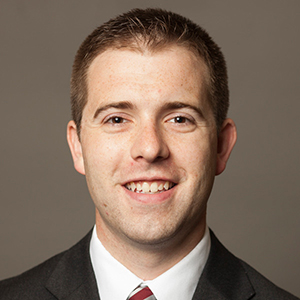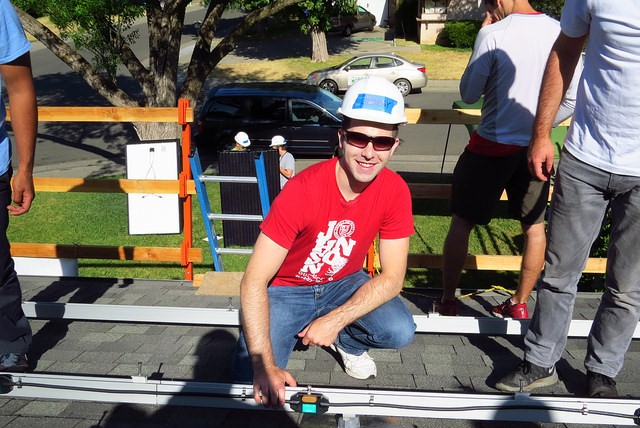Taking Part in the Renewables Revolution

by Jeremy Kuhre, MBA ‘16

Jeremy Kuhre, MBA ’16 uses his newly acquired MBA skills to do things that matter, deliver value, and tackle complex problems.
“Get DOWN!”shouted our river guide. We had just entered the Tunnel Chute, a class IV+rapid on the Middle Fork American River near Tahoe, California. I was in thefront of the raft, so I could see everything happening clearly. We hadsuccessfully entered the rapid and were now instructed to hold on for dear lifeas we rode the chute—no amount of paddling would change our course now. We knewthat if we hadn’t executed the entry correctly, there was a good chance we’dhave an encounter with the “headchopper” overhang, so-called because it was theperfect height above the water to do what it was named for. Ominously, we had justseen the raft in front of us get dangerously close to the obstacle. Thanks to askilled guide, an earnest team effort, and no doubt some amount of luck, wecleared the “headchopper” with plenty of room to spare. We whooped, high-fived,and, I’d be lying if I said there wasn’t a bit of giggling. This was living!
This summer,I’m working at SunEdison as an intern in their Solar Leadership Program (SLP). My fellow SLP interns from Ross and Tuck and Ihad been tasked with planning a retreat for the rotational leadership program.We had chosen to do a rafting trip. It was on that rafting trip, sometime afterthe Tunnel Chute, on the lazy middle leg of the river that I realized that Iwas fulfilling the goals I had made for the summer, namely:
- Do things that matter
- Use my MBA skill set to deliver value
- Work on motivated teams to tackle complexproblems
First, Iwanted to do things that mattered. In regards to my career, this means movingthe world’s economy to clean sources of energy. I chose to come to SunEdisonfor this reason, and I haven’t been disappointed. SunEdison is the world’slargest renewables company. It provides vertically integrated solutions forsolar, wind, and an increasing offering of innovative technologies.Historically, it has been known as an innovator. It was the first company towidely use power purchase agreements for solar (i.e. the “no upfront cost”model). It made waves last year through its IPO of TerraForm Power, asubsidiary that provides a very low cost of capital for the renewables assetsthat SunEdison develops and owns. Today, CEO Ahmad Chatila, wants to makeSunEdison the world’s first renewables “supermajor,” and he’s serious. Duringthe 8 weeks I’ve been here, billions of dollars of acquisitions have beenannounced including Vivint Solar, the nation’s largest residential solarcompany, second only to SolarCity.

In additionto believing in the general mission of the company, “doing things that matter”has manifested itself in countless smaller ways at SunEdison. To provide oneexample, I had the opportunity to volunteer for GRID Alternatives, a nonprofitorganization that brings the benefits of solar technology to communities thatwould not otherwise have access. My team installed a 4.4 kW system on theGonzales home in Sacramento. The family was grateful for the experience, but sowas I — I learned the nuts and bolts of installing a solar system giving me adeeper understanding of the business I’m in.
My secondgoal was to use my MBA skill set to deliver value this summer. While the summeris not yet over, I do feel that I have been able to apply my knowledge in waysthat have been valuable for SunEdison. One of my principle projects is toconduct a root cause analysis on why our projects sometimes miss their target constructiondates. On-time project delivery is a key success factor for a renewablesdeveloper because it reduces three costs: construction finance charges, manpowerrequirements, and debt requirements. As someone with a construction managementbackground, I can confirm that construction projects are chronically late.What’s more, construction managers are often so focused on completing openprojects, it can be difficult to schedule post-mortems and review the processstrategically. That’s what an SLP intern is for! I’m uncovering someinteresting, data-driven insights, and preliminary feedback from my colleagueshas been positive.
AlthoughI’ve been able to apply skills from most of my MBA classes this summer,statistics and data visualization have proved to be particularly useful.Numerous other experiences at Johnson were also essential in preparing me todeliver real, actionable value this summer. For instance, during the springsemester, I was introduced to SunEdison’s culture and people through mySustainable Global Enterprise (SGE) Immersion consulting project. Moregenerally, and perhaps a bit surprisingly, Johnson was the right school toprepare me for energy/tech-oriented company in the Bay. Johnson is making aname for itself in technology through its tech-focused campuses in New York andTsinghua, and the Bay-area boasts the largest number of Johnson alumni secondonly to NYC.
Last, Iwanted to be part of a motivated team tackling complex problems. The SolarLeadership Program was created to develop management talent and prepareassociates for future leadership roles in the company. As such, it emphasizesbroad training across different functions (four six-month rotations forfull-time participants) as well as mentoring and training. Despite a rapidlychanging company, I have found that the program is well-regarded and supportedthroughout SunEdison.
It’s beenfulfilling to be on a team of individuals who believe in what we’re doing,whether it’s braving the Middle Fork American River or planning the next stepsof the renewables revolution.
